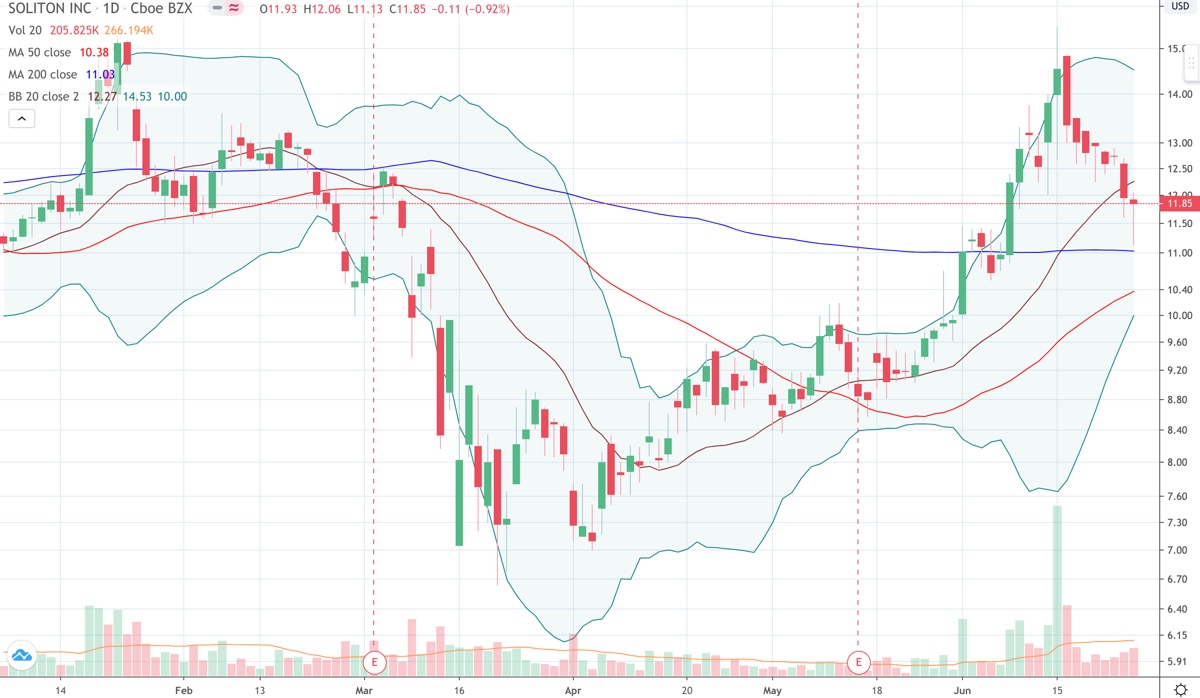Last week, I anticipated that Soliton would announce a secondary offering of stock following the release of a successful trial of its cellulite treatment. Soliton (SOLY) delivered with after hours news of a secondary stock offering in the form of an SEC filing. So now what?
The Trade Rules
At the time of writing, traders responded to the after hours news of the stock offering by taking SOLY down as much as 16% to $10. This list describes how I trade around a secondary offering of stock:
- Wait for the company to announce the number and price of shares in the offering.
- If the stock manages to close above the offering price after the announcement, then buy a “half” position.
- If the stock closes below the offering price, continue waiting.
- If the stock closes above the offering price after the secondary, buy a half position.
- If the stock closes below the offering price after the stock offering, keep waiting. The next buying opportunity needs to wait for a successful test of an important level of support like the 50 or 200-day moving average (DMA) or a previous low. See below for more.
- If the stock falls below the offering price while holding a full (100%) position, consider stopping out the stock and waiting for a new entry point (lower or higher).
The basic idea is to allow the market to communicate its interest in the stock and faith in the company. The offering price becomes an important pivot point.
These observations are most critical for a development stage company like Soliton with no revenues and for an extremely speculative stock like SOLY that trades well above its book value ($0.46 per share). I particularly like waiting in Soliton’s case because the company absolutely needs to get this deal done. The company could be motivated to set a very attractive buying price. If the offering price becomes a ceiling on the stock, then traders and investors should demand a greater risk discount before buying the stock. A potential rock-bottom range for SOLY should be between $7, the March lows, and $9, the closing price after May earnings.
More aggressive traders and investors can of course choose to jump immediately into the stock upon the weakness that typically follows announcements of secondaries in stocks like SOLY. (Note I never sign up for secondary offerings although I would consider one if the pricing comes at a significant discount to the prevailing stock price. Unfortunately, it is extremely difficult {impossible?} for retail investors to snatch such deals).

Source: TradingView.com
The Soliton Secondary Stock Offering
The prospectus supplement that describes the stock offering does not include sizing or pricing information. However, there are a few nuggets of interest:
- Soliton will use the proceeds for “…support costs to launch our products including sales and marketing spending; development of our device to be sold commercially including tooling and fixtures for manufacturing and inventory build; regulatory and clinical efforts to expand our pipeline; brand development spending; and for working capital and general corporate purposes.”
- Remeditex Ventures, LLC is likely to remain the largest shareholder of Soliton.
- Cantor Fitzgerald & Co. will serve as the underwriter.
- Soliton executive officers and directors will not be able to sell stock until 75 days after the date of the underwriting agreement. A limited number of exceptions exist.
- Soliton will be unable to sell stock until 90 days after the underwriting agreement. A limited number of exceptions exist.
From reading the prospectus, I also learned that Remeditex Ventures has a very specific and detailed framework that controls its ability to sell shares. The most interesting part of that framework allows Remeditex to sell some stock if SOLY falls below $7.00. This clause acts like a small escape hatch if SOLY fails to meet other conditions that allow Remeditex to sell. Suddenly, the March lows just above $7.00 “make sense.”
Soliton should generate enough cash from the deal to fund its needs to get a product launched according to its current timetable for the first half of 2021. Given current cash burn levels and the company’s estimate that it will run out of money by December, I am guessing the offering will target a $7M raise, just 3% of market cap as of Thursday’s close. Anything significantly less will open the door for the potential of another offering later in the year…and accordingly I would reduce the amount of shares I buy into this dip.
I expect the stock to firm up, even rally strongly, as the details of the launch plans become clearer. The most important parameters will be initial sales volumes and unit prices. The approval of a 510(k) application for the cellulite indication is critical to the company’s current strategy. Anticipation of that approval could provide an earlier rally narrative for SOLY. Soliton expects to achieve clearance in another 6 to 9 months.
Be careful out there!
Full disclosure: no positions
